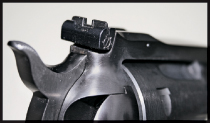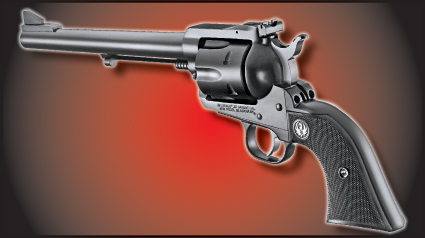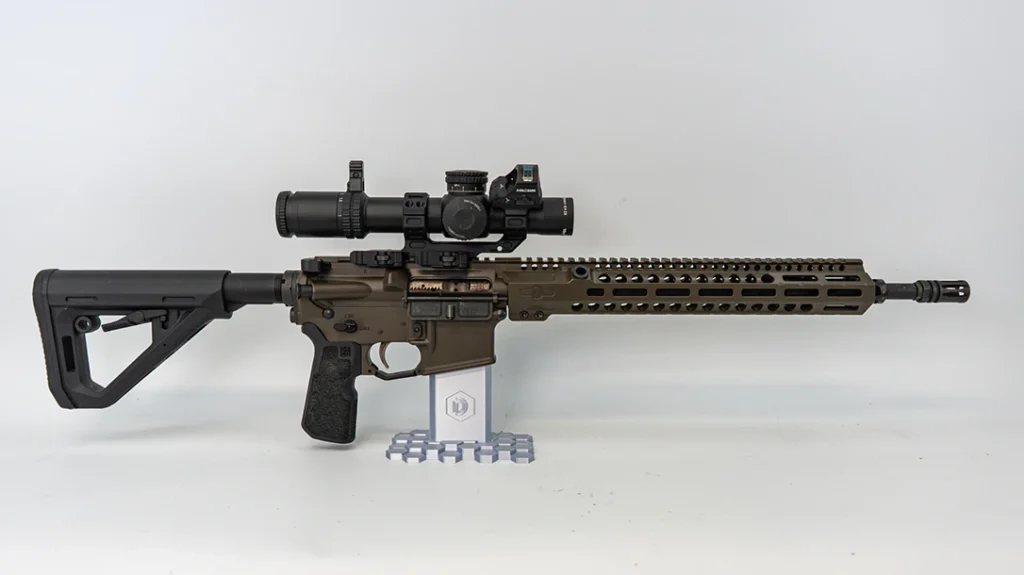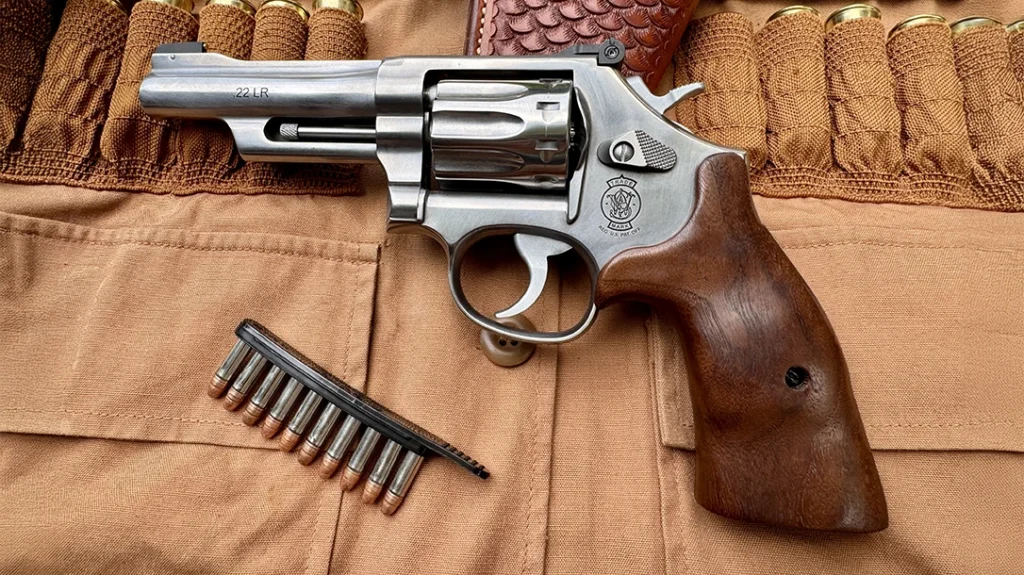Over the years, the Blackhawk has been going through an evolutionary process, and today it’s far better than the original. The line has grown from the original .357 Mag chambering to include .44 Mag, .45 Colt, .41 Mag and the .30 Carbine. Let’s not forget the 9mm/.357 Mag and .45 Colt/.45ACP convertibles. Different barrel lengths have been offered and a few different models fabricated from stainless steel have also been in the mix.
 Without question, the most unappreciated of the Blackhawk offerings has been the .30 Carbine. Although this number has been in the Ruger Blackhawk lineup for 40 years, I’ve never encountered one until now.
Without question, the most unappreciated of the Blackhawk offerings has been the .30 Carbine. Although this number has been in the Ruger Blackhawk lineup for 40 years, I’ve never encountered one until now.
I like to trek down the least traveled path. New territory is always preferable to the view that never changes. The fact that I was sitting on a can of GI .30 carbine ball ammo only made the project more appealing.
Advertisement — Continue Reading Below
Particulars
The Ruger Blackhawk casts a similar profile to the classic Colt SAA, but with several notable differences. To better tame heavy magnum loads, the Blackhawk has a little more beef. As indicated earlier, the Blackhawk features adjustable sights to better synchronize point-of-aim to point-of-impact with a wide range of loads. The Ruger revolver is also equipped with coil springs instead of the flat leaf springs that were utilized in the Colt.
Our SA .30 Carbine revolver is actually a New Model Blackhawk. Original Blackhawks required the user to follow a loading protocol similar to the Colt SAA. But in 1973, Ruger introduced the New Model Blackhawk that simplified the loading process and also made it safe to carry with a full compliment of six rounds. A transfer bar was added that prevented the gun from firing unless the trigger was pulled. Some SA purists may take issue with deviating from the original design, but they’ll get over it.
My .30 Carbine copy was outfitted with a 7.5-inch barrel. This long tube delivers higher velocities and the long sighting plane enables one to hit targets “way out there.” Busting dirt clods on the range berm was no special trick back to 50 yards and beyond.
Advertisement — Continue Reading Below
Constructed of carbon steel, the .30 Carbine Blackhawk tipped the scales at 44 ounces. My sample sported a blue finish and a set of checkered hard rubber grip panels.
The New Model Blackhawk revolvers are now equipped with an internal lock. While no mechanical device can replace safe gun-handling and responsible storage, the lock is another layer of security. If the lock doesn’t fit into your game plan, you don’t have to use it.
Ruger has taken a somewhat different approach with their internal lock. To engage the lock, first verify an unloaded revolver and remove the right grip panel with a small screwdriver. The locking device is located between the bottom of the grip frame and the mainspring. By inserting a special key and turning clockwise, the revolver cannot be cocked and fired. The grip can be reaffixed and the gun rendered inert for storage. A 180-degree counterclockwise turn puts the lock in the “off” mode and is capable of being fired.
Advertisement — Continue Reading Below
If one were to frequently take advantage of this feature, the lock can be accessed directly through the grip panel. The hard rubber right side panel has a drill point to correctly landmark the lock keyway. By drilling this out, the lock can be accessed without removing the grip panel.
Bianchi Lawman
My old Bianchi crossdraw holster proved a bit too short for the 7.5-inch barrel of the New Model Blackhawk. This holster has been subjected to some very hard wear and remains serviceable despite being almost 35 years old. It was quite logical that I would choose another Bianchi holster to mate up with the .30 Carbine Blackhawk.
For this long tubed sixgun, I went with the Bianchi 1L Lawman. This classic holster is made of premium leather that is double stitched and features a conventional retention strap. Designed exclusively for SA revolvers, this holster carries the gun at an optimum angle for drawing when riding on horseback or in vehicles. The fold-over belt slot fits 1-3/4- to 2-1/4-inch wide belts.
Advertisement — Continue Reading Below
For casual wear when knocking around the outback, the 1L Lawman can’t be beat. This classic design is indeed the perfect partner for the Blackhawk.
Range Time
Unlike shooting the heavy magnum calibers, the .30 Carbine Blackhawk is a pleasure to shoot. Felt recoil is mild and the SA grip frame sort of rolls in the hand rather than coming straight back like a double-action revolver.
The bark of the .30 Carbine does run a few decibels louder than other mid-bores like the .38 Special. On a cloudy day, muzzle-flash plus flash between the cylinder and forcing cone, were also visible but not especially distracting.
Advertisement — Continue Reading Below
From the Hornady Delta Rest, 25-yard accuracy potential proved very good. My best efforts with some old GI ball were just over 2 inches. With the CorBon DPX load, I managed a few groups that measured under 1.75 inches. In one cluster, I managed to place four bullets in one ragged hole, only to spoil it with a fifth flyer. Muzzle velocities are pretty zippy with the ball load clocking 1528 fps (feet per second) and the CorBon DPX averaging 1482 fps through the Oehler chronograph.
Some informal sniping was also conducted at steel targets set 50 and 75 yards away. Utilizing a variety of stable field positions, 50-yard hits were a piece of cake. Ringing the bell at 75 yards required a bit more effort, but was well within the capabilities of the Blackhawk.
Closing Thoughts
The .30 Carbine Ruger Blackhawk remains a somewhat specialized piece. It’s not an authentic cowboy piece nor is it suitable for big game hunting or formal target shooting. My supply of old ball ammo aside, I really wouldn’t categorize it as a low-cost plinker. There are, however, a number of things it does exceptionally well.
Advertisement — Continue Reading Below
I was truly impressed with the Blackhawk’s ability to place hits on a target set far in the distance. Sure, there are other Ruger offerings that one can accomplish this with, but none as mild mannered as the .30 Carbine. Low recoil adds up to all-day shooting comfort. Its classic handsome look further compliments its role as a field carry gun.
If hunting chucks, javelinas or coyotes is your game, the .30 Carbine Blackhawk is an excellent choice. Terminal effect, particularly with CorBon DPX, should be very good. At short to intermediate range, this combination will do the trick and take game cleanly. Handloading the .30 Carbine cartridge is easy and the Blackhawk revolver should prove flexible in working up some good loads.
The .30 Carbine Blackhawk boasts some unique capabilities not found in other revolvers. For pure fun, this much-misunderstood Blackhawk is just the ticket.
Advertisement — Continue Reading Below
























